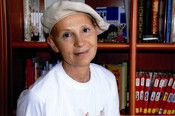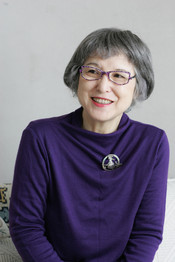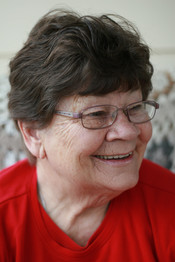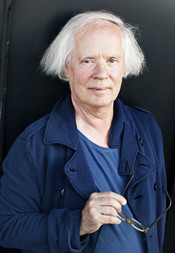HCAA 2018 Shortlist - Authors

France
Marie-Aude Murail
Marie-Aude Murail was born 1954 in Le Havre into a family of artists: her father is a poet, her mother a journalist, her brother Tristan is a composer, her brother Lorris and her sister Elvire (pseudonym Moka) are writers for children. She studied literature at the Sorbonne University where her doctoral thesis was about the adaptation of classic novels for young readers. At 23 she started writing romances for women’s magazines and eight years later she published her first novel for adults. She began writing tales, stories and novels published in the magazines of the Bayard Group, including Astrapi, J'aime Lire and Je Bouquine. In 1987, her first children’s novel, Mystère (Mystery), was published and from then on she devoted herself to writing for children and young people.
Marie-Aude Murail has a gift for creating characters that have a special bond with the reader. Her novels explore various themes of politics, history, love, adventure and fantasy and have been translated into more than 22 languages. She has been awarded most French prizes in the field of children’s books, the story Miss Charity (2008) was included in the 2010 IBBY Honour List and she has been nominated twice, in 1996 and 1998, for the Hans Christian Andersen Award. In 2004 she was made “Knight of the Legion of Honour” - the highest French order for military and civil merits - in recognition for her work in the field of children’s literature. In parallel with her writing, she is an activist for literacy and the development of children’s reading skills as well as the rights of refugee and migrant children.
HCAA Jury Comments:
Marie-Aude Murail is unafraid of challenging topics and themes and she transcends the genre of ‘problem book’ through the freshness, originality, and humour in her books. An exacting author, deeply engaged in the rights of children and young readers, she is very committed to knowing them, understanding their world, and presenting a true portrait of their lives.

Iran
Farhad Hassanzadeh
Farhad Hassanzadeh has had an influential presence in children’s and young adult literature in Iran in the past quarter century. Through his novels, stories, rewritings of old tales, poems, biographies, and journalistic essays, he has been able to encourage a broad spectrum of audiences in various age groups to read literary works. He was born in 1962 in Abadan, a town in the south of Iran by the side of the Arvand River on the Iran-Iraq border. During the eight-year Iran-Iraq war, Abadan became a war zone and many of its citizens had to abandon the town. After leaving Abadan and going through many jobs, he was finally able to engage in his chosen career of creative writing. His diverse experiences have enabled him to create a broad spectrum of characters, circumstances and locations and he writes for various age groups. He has written about the effects of war on civilians, migration and vagrancy, teenage love, children in shantytowns, teenagers’ special worlds, marginalized or fringe characters, social taboos, as well as different geographical regions and areas.
The strength of his fiction is not limited to his courage in bringing up fresh topics, especially in young adult novels. The form and expressive style he uses in his works are also creative and make them interesting to read. Farhad Hassanzadeh has succeeded in creating over eighty works and won more than thirty national awards. His best known works include the short story collection Kenare Daryache Nimkate Haftom (The seventh bench on the lake, 2006), the young adult novels Mehmane Mahtab (The moon’s guest, 2008), Aghrabhaye Keshtiye Bambak (Bambak’s Scorpions, 2009-2016) and Hasti (Hasti, 2010) as well as the children’s book Ghesehaye Kooti Kooti (Kooti tales, 2014). His stories have been being adapted into films and plays. He received the Art Medal of the First Degree from the Ministry of Culture and Islamic Guidance for creating lasting characters in children’s and young adult literature.
HCAA Jury Comments:
Farhad Hassanzadeh is complex, compassionate, funny, and heartbreaking. His books are an example of what writing for older children and young adult readers should be. Unafraid of difficult topics he is able to present them in such a multi-dimensional way that the reader can find understanding, solace and empathy in his work no matter the subject.

Japan
Eiko Kadono
Opening a book is like opening the door to different worlds. But what the end of a book brings us is not the closing of a door, but the opening of other doors, because when we read a story we come to see different worlds, and they are, in turn, beginnings.
Eiko Kadono was born in Tokyo in 1935. When she was ten, she was evacuated to northern Japan during WWII. These memories formed the basis of one of her best-known stories, Rasuto ran (Last run, 2011), and the experience of war as a child is at the root of her commitment to peace and happiness. She studied American literature and then travelled extensively in Europe as well as in North and South America and began writing. She has published nearly 200 original works – picture books, books for pre-schoolers, fantasies, stories for young-adult and essay anthologies – as well as translated into Japanese more than 100 works by foreign authors including works by Raymond Briggs and Dick Bruno.
Her distinctive way with words and view of the world through the eye of the child has captured young readers from the 1970s onward. Her Little Ghosts series featuring good food and ghosts—two subjects always popular with children—presents the exploits of quirky characters Acchi, Kocchi, and Socchi. Kadono’s literature is populated with unique characters endowed with the virtues and foibles of human beings everywhere, and her mellifluous style is touched with whimsy and humour. Her best-known works include Zubon senchosan no hanashi (Tales of an old sea captain, 1981) and Odorobo Burabura-shi (Grand thief Burabura, 1981), both of which have won prizes in Japan. In 1985 she published the first of six volumes of Majo no takkyubin (Kiki’s delivery service, 1985) that won the Noma and Shogakukan Prizes and was selected for the IBBY Honour List in 1986. Eiko Kadono has also been a champion of reading and books for children and has been recognised for her contributions to children literature with the Medal with Purple Ribbon in 2000, and the Order of the Rising Sun – Gold Rays with Rosette in 2014. She was nominated for the Hans Christian Andersen Award in 2016.
HCAA Jury Comments:
Eiko Kadono is innovative, unique, fresh, sometimes haunting. Always memorable, this writer brings diverse approaches to books that address a wide variety of ages. Her playful language as in the lilting onomatopoeia in her picture books, her powerful, free-wheeling imagination, her humour and insight into children and young people’s feelings make her an author who combines exceptional literary quality with accessibility.

New Zealand
Joy Cowley
Joy Cowley was born as the eldest of five children in Levin in 1936. She initially struggled with reading and writing in school and when one of her own children had the same difficulties she began writing stories that appealed to him. Her first children’s stories were published in The School Journal, a publication distributed free to schools in New Zealand. She has written early-reader books that have become classics in New Zealand and subsequently spread all over the English-speaking world. She has said of her philosophy of books for new readers: Children learning to read need to see themselves as successful long before they are in fact fluent readers. They need a real story that is interesting, entertaining, educationally and emotionally supportive, a story that is child-centred.
Her two most famous characters are Greedy Cat (1983) and Mrs Wishy-Washy (1980). She has written books for emergent readers, picture books such as The Duck in the Gun (1984) and Snake and Lizard (2007), educational books such as The Red-Eyed Tree Frog (1999) as well as young adult fiction, Dunger (2013). Twists and turns of relationships feature in much of Joy’s writing as does her love of the New Zealand countryside, both feature in Dunger where she explores family relationships with wit, warm humour and wisdom.
Joy Cowley has been actively involved in encouraging young writers through courses, seminars and workshops worldwide. Her enormous contribution to children’s literature has been recognised with some of New Zealand’s highest honours: Order of the British Empire (OBE) 1992 for services to children’s literature, Distinguished Companion to the New Zealand Order of Merit 2005, New Zealand Prime Minister’s Award for Literary Achievement in Fiction, 2010 and the 1993 Storylines Margaret Mahy Medal. She was nominated for the Hans Christian Andersen Award in 2016. Joy Cowley is the Patron of Storylines Children’s Literature Charitable Trust of New Zealand which, in 2002, established the Joy Cowley Award for picture book manuscripts.
HCAA Jury Comments:
Joy Cowley is a writer of everyday life in all its dimensions. This remarkable, prolific author is fresh, relevant and utterly accessible to her child readers. Her ability to draw in children through her wonderful story telling skills and mastery of the child’s voice have made her an especially important force in the creation of young readers in many countries.

Sweden
Ulf Stark
Ulf Stark was born in Stureby, near Stockholm in 1944 and died in June 2017. He has written poems for children, picture books, middle grade novels as well as young adult literature. His writing breakthrough came in 1984 with Dårfinkar och Dönickar (Fruitloops and dipsticks), a novel for teens that revolutionized literature for young people in Sweden. Its fresh, energetic language and authentic character portrayal resonated with readers. The female protagonist, Simone, by mistake thought of as a boy called Simon, challenges every preconceived notion of gender identity. The story is boldly and finely balanced between the most profound seriousness and crazy humour. Ulf Stark has said: I think grief has to be included so that the joy is clear.
Many of his stories are set in the landscape of his childhood, Stureby, most notably the critically acclaimed Stureby series that includes Min vän Percy’s magiska gymnastikskor (My friend Percy’s magical gym shoes, 1991). In 1992 he wrote another classic of Swedish children’s literature, Kan du vissla Johanna? (Can you whistle Johanna?), which was nominated for the prestigious August Prize, won the Deutscher Jugendliteraturpreis in 1994 and was adapted into a popular film. In 1993 he received the Astrid Lindgren Prize from Astrid Lindgren herself. Other well-known books include Min vän shejken i Stureby (My friend Sheik in Stureby, 1994) and Min vän Percy, Buffalo Bill och jag (My friend Percy, Buffalo Bill and I, 2004) in the Stureby series, the picture book, När papa visade mig väridsalltet (When dad showed me the universe, 1998), Jul i Stora Skogen (Christmas in the big forest, 2012), En liten bok om kärlek (A little book about love, 2015) and Djur som ingen sett utom vi (Animals like no one, only us, 2016). Ulf Stark was nominated for the Hans Christian Andersen Award several times and was a Finalist in 2000.
HCAA Jury Comments:
Ulf Stark, though now tragically deceased, wrote with delicacy and humour. His books contain sadness, courage, strength, grief and joy, usually all at once. They describe real lives, gripping plots with laughs and comfort along the way even when things are tough. This is the great gift he gives to his readers, who respond by loving his books.

